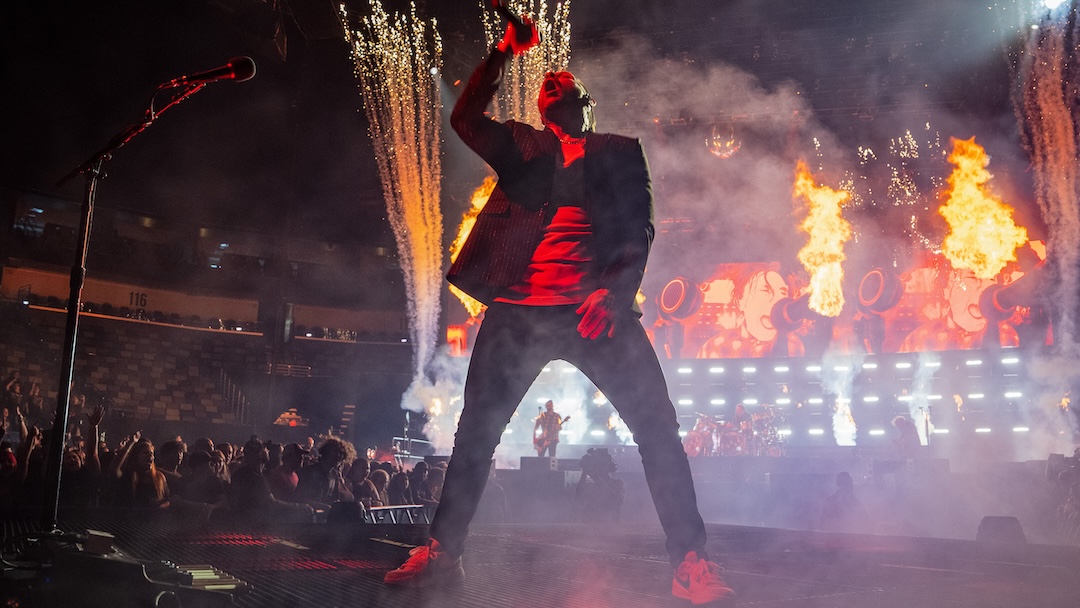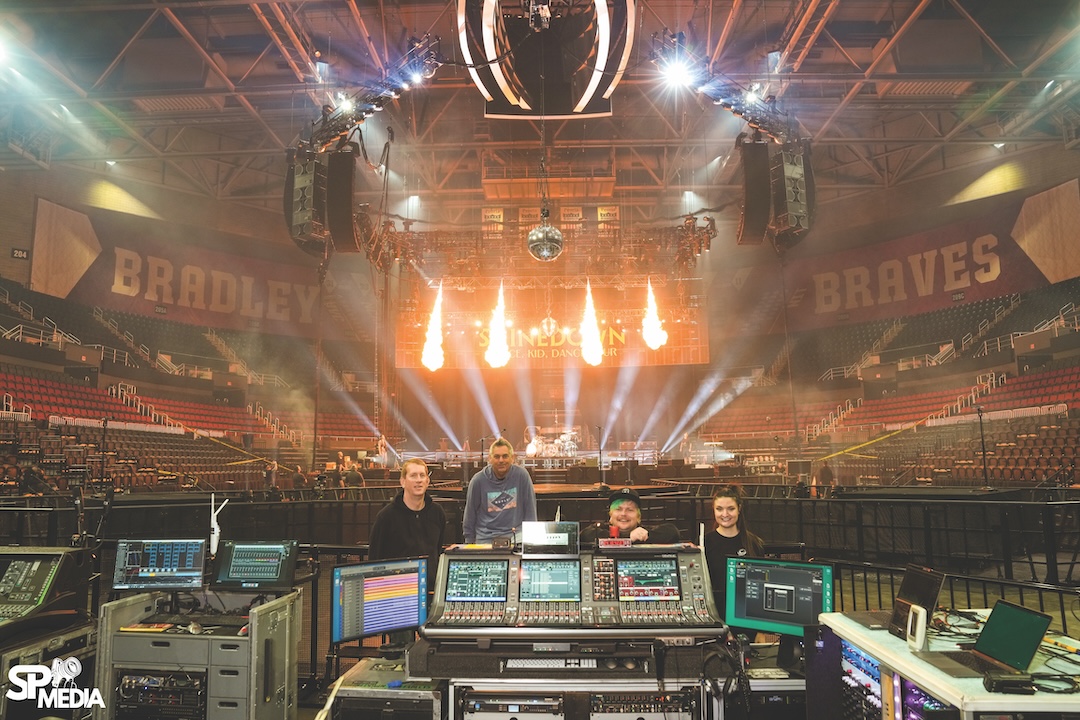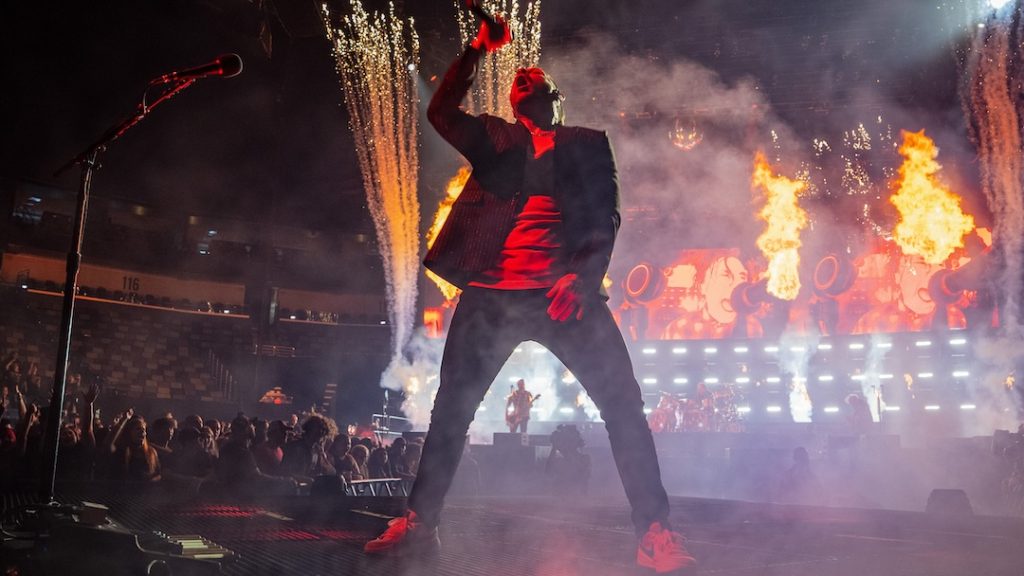
New York, NY (July 15, 2025)—After two months off, Shinedown returns to the road this Saturday in Boston, ready to pack the TD Garden arena and Rock with a capital “R.” Helping make that happen every night are FOH engineer Andy Meyer and monitor man Chris Lightcap, overseeing audio gear provided for the trek by Clair Global.
A veteran presence in the Shinedown camp, Lightcap began working with the group in 2007, while Meyer took on the FOH role in 2019, though he’d crossed paths with the band before. “I did one of Shinedown’s very first shows around 2003,” he says. “I worked for another band with their management and was asked to help out on a show in St. Petersburg at Jannus Landing; fast-forward 16 years and I ended up working with them.”
Meyer tackles the show mix nightly on a Yamaha Rivage PM5 surface, which he started using on the first Shinedown tour after the pandemic, citing an appreciation for the platform’s reliability and sound. Lightcap soon followed, opting for a Rivage PM10. “Andy made the switch first, and being able to see what that desk was capable of and what he was doing with it made me want to jump on it,” Lightcap recalls. “My biggest thing was getting away from external plug-ins. I had a lot, and some of them were just there for time management and stuff I really wasn’t using, but I had to put them there just to keep things in line. Now I’m completely in the box; monitorworld is all in the desk.”

Meyer jumps in to add, “You don’t need external anything on this desk; the internal effects are awesome, like their stock compressors, stock gates, the Neve plug-ins like the Master Buss Processor. You have the reverbs—Bricasti, Eventide H3000, and there’s older Yamaha SPX platform stuff, so you have phasers and flangers and delays. You’ve got anything you could really need inside the desk, and they all sound great. That Neve Primary Source Enhancer is baked into it and I have one of those on every vocal mic, and then I also utilize the gating as well.”
That said, Meyer also has 40 spaces of outboard gear racked up at front-of-house. “There are some pieces I couldn’t do without,” he says, “like the old-school Rupert Neve Portico II Master Buss Processor, the actual analog one I have in my rack; I would not want to do a gig without that. I made the mistake of taking it out once, and that was only once—it went right back in. There’s just a vibe running through it that you can’t beat. Also, I’ve got some SPL gear—their PQ Mastering Equalizer and the SPL Iron, which is their mastering compressor; those two pieces are serving me well. Right next to that, I’ve got a Thermionic Culture Phoenix compressor; they were started by the late Vic Keary, a good friend of mine.”
Elsewhere in the venue, Meyer has copious amounts of Teegarden Audio Magic Pre 4100 preamps hard at work: “They sound great, so I have proper analog mic pre’s, and then I use two Direct Out Technologies Andiamos as converters. I run right into a real mic pre, and then I convert it into MADI, and that’s how I get it into my desk.”
Inside the Live Sound of Live Aid, Part 1: London
The result of all that gear—the house mix— covers the audience courtesy of a Cohesion P.A. system, built around 60 CO12 boxes, parceled out with main hangs of 16 boxes each and side hangs of 14. Bolstering them are a half-dozen flown CP218 subs, supplemented by an additional three ground stacks of three. Completing the sonic picture are CF28 front fills. “They voiced their new front fill very well; it sounds just like Cohesion itself, so it’s an awesome transition,” says Meyer.
For the engineers, one of the bigger challenges of a Shinedown show is inadvertently caused by that P.A., simply because the band likes to spend a lot of time in front of it on a stage thrust that runs 80 feet out to a B stage with two wings. With 16 vocal mic positions out front—all sE V7 vocal mics—both engineers are on their toes mixing throughout the entire show. “For me, it’s a lot of snapshots,” says Lightcap. “I’ll have one for when these guys are there and then another when they come back to the main stage and so on.” Meanwhile, Meyer breaks down each song into snapshots for individual verses, choruses and more, sometimes using as many as 16 in a given song—which means he has more than 400 snapshots saved in his desk.
The drum kits—plural as there’s one out on the B-stage as well—are miked identically, surrounded by an assortment of sE Electronics offerings, with snares captured with V7 X, sE8 and T2s; toms heard via V Kicks; a BL8 in the kickdrum; and sE4400s placed under all the cymbals, with help from the new sE7 sideFire on ride and hi-hat. Above them all are two pre-release versions of the brand-new sE6160 shotgun mic: “They sent it to me, I tested it and it’s great,” Meyer reports.
Discover more great stories—get a free Mix SmartBrief subscription!
They’re not the only shotguns on-hand, however; Lightcap makes use of four different pairs of Sennheiser MKH 416s located on the stage, the wings and at FOH to capture the crowd for the band’s in-ear monitors. “For ears, we’re using Wisycom MTK 982 transmitters, which are light years ahead not only on the RF side, but also the audio side—it has the space, it’s flat, it’s true and it’s like mixing a P.A. in your head,” says Lightcap. “Then we’re using all JH Audio ear pieces—a combination of Roxannes and the new Ruby V2 and Pearl system. The Pearl is like an active earpiece; you have your in-ear pack and then you have a Pearl processor pack, which does all your crossover points, your time alignment and so on. It’s quite the experience, honestly; for the guys in the band who switched to the Pearl stuff, we started pulling back drums and bass guitar in their mixes because it responds so much better—the low-end clarity in that Pearl system is quite impressive.”
Another new addition to Lightcap’s arsenal is SoundBase, a web-based app for frequency coordination. “It’s been a game-changer for me,” he says. “I do a real-time frequency report and email the link to my backline guys every day so if they need to switch a frequency in the middle of the show, they have the whole frequency report right there on their phone. That’s been really handy.”
The app is getting put to good use on the Dance, Kid, Dance tour as well. The tour takes its title from the most recent Shinedown single and kicks off its second leg this month in Boston before careening across the U.S. for 26 shows through the end of August. If the first leg was anything to go by, audiences will get treated to an old-school arena rock concert, getting two hours full of pyro, lights and Shinedown’s seemingly endless string of hits—the kind of show where fans go home hoarse but happy.

